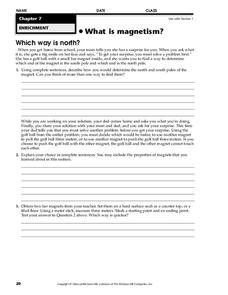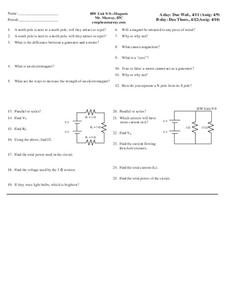Vosonos
Interactive Minds: Solar System
Travel through space as you learn about the galaxy, solar system, planets, and much more. An extensive resource for studying astronomy in upper-elementary and middle school classrooms.
Curated OER
Terrabagga Activity Using a Magnetometer
Clever! Earth science learners construct a model of a planet containing a magnetic core. The planet, Terrabagga, is made out of a paper grocery bag, magnets, a dead D battery, and rubber bands. Pictures of each step of the construction...
Curated OER
Magnets
What a great way to have your second graders explore magnetism! Learners conduct an experiment in which they identify objects attracted to magnets. Then, they create a presentation in which they display objects involving magnets.
Curated OER
The Magnetometer
Physical or earth science pupils prepare a magnetometer by inducing magnetism into a pair of straight pins. As the pins hang from a thread, they can be used to detect the magnetic field or poles of a magnet. They could also be used as a...
Curated OER
Magnetism
If you are looking for a concise set of slides dealing with the basics of magnetism, look no further. Each slide defines a different magnetism concept: poles, fields, atoms, currents, electromagnets, motors, and generators. The only...
Curated OER
Magnetism
Attract your class to magnetism with this straightforward presentation. Using bullet points and simple phrases, viewers are taught the basics of magnetism. There are no pictures or diagrams to help explain, so you might want to add a few...
Curated OER
Magnetism
Provide physical science explorers an overview of magnetism with this collection of slides. The third slide posts hyperlinks to websites that cover magnetic fields in detail, so ideally this presentation would be viewed by small groups...
Curated OER
Magnetism
In this magnetism worksheet, students answer ten questions about magnets, their magnetic poles, the magnetic lines of flux and how magnets work.
Curated OER
Magnets
In this magnets worksheet, students read for information, observe diagrams, and experiment. In this identifying the correct answer and T-Chart worksheet, students answer nine questions.
Curated OER
Which Way is North?
In this magnets worksheet, students explain how they would determine the north and south poles of a magnet. This worksheet has 3 short essay questions.
Curated OER
Magnets
Second graders classify objects and create hypotheses regarding their magnetic properties. They watch a video about magnets and finally use a magnet to test their hypotheses created earlier.
Curated OER
Naturally Magnetic Elements
Students explore naturally magnetic elements. For this magnets lesson, students examine the periodic table of elements. Students discover the parts of an atom and determine which three elements are magnetic.
Curated OER
Magnetic Poles
In this scientific investigation worksheet, students follow the provided procedures to examine positive and negative charges of magnets and then respond to 3 short answer question.
Curated OER
Science - Magnets and Non-Magnets
In this science worksheet, students identify magnetic and non-magnetic items. They match 8 items to their definitions, and answer 6 short answer questions in which they tell what they know about magnets and the electrical method.
Curated OER
Electricity
For this electricity worksheet, learners review what makes up electricity by filling in the blanks of 18 statements with terms from a word bank. Students then complete a crossword puzzle by placing 12 terms into the puzzle.
Curated OER
Magnetic Earth
In this magnetic Earth worksheet, students learn how a compass works with the magnetic poles of the Earth. This worksheet has 4 short answer questions.
Curated OER
Magnets
In this magnets worksheet, students describe the differences between a generator and a motor, define electromagnet, and identify a circuit as parallel or series. This worksheet has 2 short answer questions, 5 fill in the blank and 18...
Curated OER
How to Be "Naturally Attractive" (Without Even Trying)
Students examine the various properties of magnets, explain how a compass works and make an electromagnet. They also experiment with magnetic lines-of-force using paper and iron filings.



















